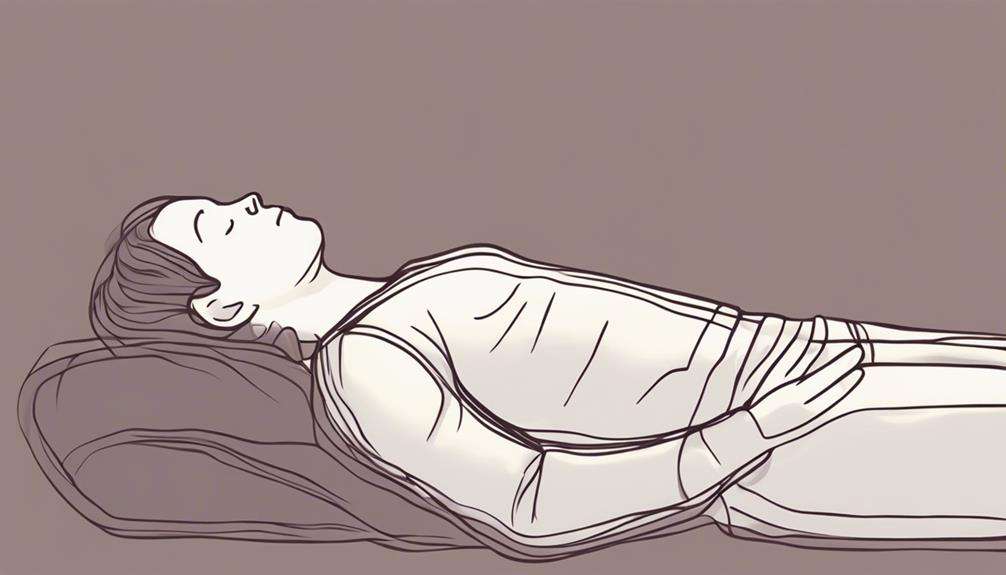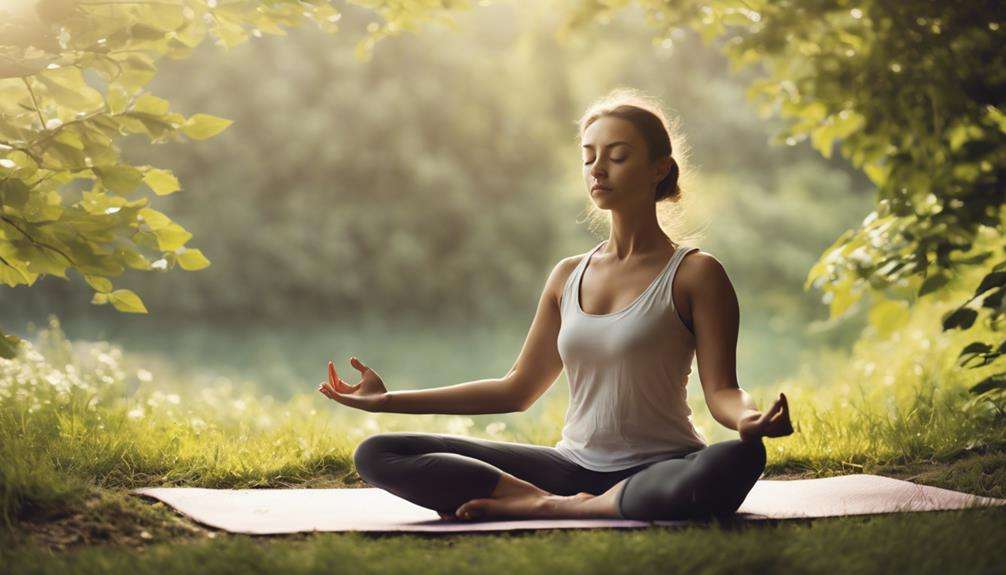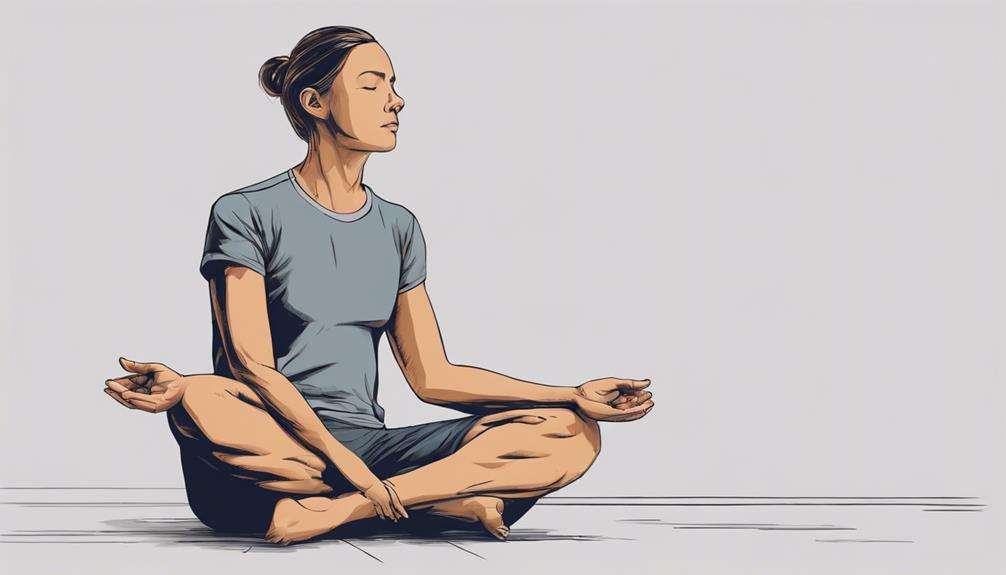Imagine coming home after a long, stressful day at work, feeling the weight of tension in your shoulders and mind.
You sit down, close your eyes, and begin to focus on your breath…
Key Takeaways
- Meditation techniques offer a sanctuary for the mind, reducing stress and fostering tranquility.
- Deep breathing and visualization techniques effectively calm the mind and lower stress levels.
- Mindfulness practices like yoga and meditation promote relaxation, emotional resilience, and tension reduction.
- Incorporating deep breathing, visualization, and mindfulness practices enhances overall well-being and reduces tension effectively.
Benefits of Meditation Techniques
Meditation techniques offer a soothing sanctuary for your mind, easing stress and fostering a sense of inner tranquility. By incorporating mindfulness practices into your daily routine, you can reduce the impact of stress on your mental health to a great extent. The benefits of mindfulness-based stress reduction are profound, allowing you to cultivate a state of relaxation even in the midst of chaos.
Regular practice of meditation techniques not only helps in managing stress effectively but also contributes to your overall well-being. When you dedicate time to meditation, you're investing in your mental health and emotional stability. The calming effects of meditation extend beyond the practice itself, influencing how you navigate through daily challenges and uncertainties.
Incorporating meditation into your daily routine can lead to a profound shift in how you perceive and respond to stressors. The practice of mindfulness offers a powerful tool for relaxation and stress reduction, enhancing your mental resilience and promoting a sense of inner peace.
Types of Relaxation Methods
To unwind and reduce tension, consider incorporating various relaxation methods into your routine.
Techniques like deep breathing exercises and visualization can help calm your mind and ease stress levels effectively.
Exploring these practices may provide you with valuable tools to promote relaxation and well-being in your daily life.
Breathing Exercises
Engage in deep breathing exercises to activate your body's relaxation response and effectively reduce stress levels. Here are some ways deep breathing can benefit you:
- Simple and Accessible: Deep breathing techniques are easy to learn and can be practiced anywhere, making relaxation convenient.
- Promotes Relaxation: Inhale deeply through the nose, letting the stomach expand, then exhale slowly through the mouth to calm the mind and body.
- Enhanced Benefits: Combine deep breathing with aromatherapy, soothing music, or mindfulness practices for added relaxation perks.
Regular deep breathing sessions not only reduce stress but also improve mental clarity, emotional stability, and overall physical well-being.
Visualization Techniques
As you seek further ways to unwind and ease tension, consider exploring visualization techniques as a powerful method to cultivate relaxation and peace of mind. Visualization techniques involve imagining peaceful scenes to release tension and anxiety.
You can practice these methods alone or with guided audio for enhanced relaxation. Opt for calming settings like a beach or a quiet forest when engaging in visualization exercises. Incorporating sensory details into your visualizations can create a more vivid and immersive experience.
Through visualization, you can promote mindfulness and relaxation by heightening your body awareness. Take time to immerse yourself in these calming visualizations to bring tranquility and serenity into your daily life.
Deep Breathing for Relaxation

Take a moment to focus on your breath, allowing it to guide you into a state of relaxation.
Deep breathing can help you ease tension and stress, bringing a sense of calmness to your mind and body.
Breath Awareness Benefits
Wondering how deep breathing can swiftly bring you a sense of relaxation and calmness?
Deep breathing is a powerful tool that activates your body's relaxation response, effectively reducing stress levels. By focusing on full, cleansing breaths, this technique promotes relaxation and calmness, providing quick stress relief wherever you are.
To enhance the stress-reducing benefits of deep breathing, consider combining it with aromatherapy or soothing music. Just a few minutes of deep breathing in a quiet space can have immediate calming effects on your mind and body.
Embrace the simplicity of deep breathing to reveal its potential in improving your overall well-being.
Diaphragmatic Breathing Technique
If you seek a technique to swiftly induce relaxation and calmness, consider incorporating diaphragmatic breathing into your daily routine. Diaphragmatic breathing, also known as deep breathing, involves inhaling deeply through your nose to expand your diaphragm and fill your lungs completely.
This technique triggers the body's relaxation response, helping to reduce stress, alleviate tension, and promote a sense of calm and well-being. By practicing deep breathing for just a few minutes each day, you can experience a significant decrease in anxiety levels and an increase in mental clarity.
Integrating diaphragmatic breathing into your daily routines provides a simple yet effective way to manage stress and enhance your overall well-being. Start incorporating this powerful relaxation technique into your life today for a healthier mind and body.
Progressive Muscle Relaxation Practice
Engage in progressive muscle relaxation practice to systematically release tension and achieve complete physical relaxation throughout your body. This systematic technique targets different muscle groups, helping you release muscle tension and promoting a sense of calmness.
Here are three key benefits of progressive muscle relaxation:
- Tension Release: By tensing and relaxing each muscle group, you become more aware of where you hold tension in your body, allowing you to ensure it effectively.
- Physical Relaxation: Progressing from your feet upwards, this practice checking that every muscle group experiences relaxation, leading to an overall sense of physical tranquility.
- Stress Relief: Combining deep breathing with progressive muscle relaxation enhances stress relief, offering a holistic approach to relaxation and tension release.
Body Scan Meditation Benefits

To experience the numerous benefits of body scan meditation, begin by focusing your attention on different body parts sequentially. This practice helps increase body awareness, allowing you to explore areas of tension and discomfort that may have gone unnoticed.
By systematically scanning your body, you promote relaxation, reduce stress, and foster mindfulness. Body scan meditation enables you to release physical tension, providing relief to both your body and mind.
As you explore deeper into this practice, you'll cultivate a profound connection to your physical sensations, enhancing your overall well-being. Through the calming nature of body scan meditation, you can ease both physical and mental strain, creating a harmonious balance within yourself.
Embrace this technique to not only relax but also to develop a heightened sense of self-awareness and tranquility.
Visualization Techniques for Relaxing
Visualize peaceful scenes to enhance relaxation and reduce tension by incorporating sensory details for a more vivid experience. Imagination plays a vital role in visualization techniques for relaxation. Here are three ways you can make the most of this practice:
- Choose Calming Settings: Opt for serene environments such as a tranquil beach or a quiet forest in your mind's eye. These calming settings can help amplify the effectiveness of your visualization exercises.
- Incorporate Sensory Details: Engage all your senses by visualizing not just the scene but also the sounds, smells, textures, and even tastes associated with it. This multisensory approach can deepen your relaxation experience.
- Use Guided Audio: Consider utilizing guided audio sessions that lead you through peaceful visualizations. These can provide structure and support, enhancing your ability to focus and relax through visualization techniques.
Self-Massage for Stress Relief
Incorporate self-massage techniques into your daily routine to effectively alleviate stress and promote relaxation.
Self-massage is a powerful tool for managing stress, as it helps release muscle tension and induce a sense of calmness.
By incorporating aromatic oils or scented lotions into your self-massage routine, you can enhance the relaxation experience and create a soothing environment.
Consider trading massages with a loved one to not only relax your muscles but also deepen your connection with them, further reducing stress levels.
Establishing a regular self-massage practice can greatly benefit your overall well-being by providing a moment of tranquility in your day to unwind and de-stress.
Whether you focus on specific areas of tension or opt for a full-body massage, the act of self-massage offers numerous benefits for both your physical and mental health.
Start incorporating self-massage into your routine today to experience the positive effects it can have on managing stress and promoting relaxation.
Mindfulness Meditation Practices
Engage in mindfulness meditation practices to cultivate present-moment awareness and promote emotional balance. Mindfulness meditation involves observing thoughts, emotions, and bodily sensations without judgment, allowing for non-reactive awareness. This practice enables you to witness your inner experiences, including stressors, without getting caught up in them.
Here are three benefits of mindfulness meditation:
- Improved Attention: By focusing on the present moment, mindfulness meditation enhances your ability to concentrate and be fully engaged in tasks.
- Emotional Regulation: Through the practice of non-judgmental observation, you can better understand your emotions and respond to them in a balanced way.
- Reduced Stress Levels: Studies show that mindfulness leads to structural brain changes that can help reduce stress and promote overall well-being. By incorporating mindfulness into your daily routine, you can foster emotional resilience and a sense of inner peace.
Practice observing your thoughts without judgment, and experience the transformative power of present-moment awareness.
Incorporating Yoga for Tension Reduction

To enhance your well-being and reduce tension, consider integrating yoga into your daily routine as a holistic approach to managing stress.
Yoga, a mind-body practice encompassing physical postures, breathing techniques, and meditation, is renowned for its ability to reduce tension and promote relaxation. By engaging in various yoga poses that target specific areas of tension in the body, such as the neck, shoulders, and back, you can effectively release built-up stress.
Research indicates that regular yoga practice can lower cortisol levels, decrease muscle tension, and enhance overall well-being. Additionally, practicing yoga can increase flexibility, improve posture, and heighten body awareness, leading to a reduction in both physical and mental tension.
Frequently Asked Questions
How Do You Meditate to Release Tension?
To release tension through meditation, start with deep breathing exercises and body scanning. Use visualization techniques, progressive muscle relaxation, and mindfulness meditation. Try guided imagery, mantra meditation, loving kindness meditation, walking meditation, and deep breathing for ultimate relaxation.
What Are Now the 6 Relaxation Techniques That Can Reduce Stress?
To reduce stress, try deep breathing, progressive relaxation, guided imagery, mindfulness meditation, yoga poses, aromatherapy candles, nature sounds, massages, tai chi, and journaling prompts. These techniques calm your mind and body effectively for relaxation.
How Do You Meditate to Release Muscle Tension?
To release muscle tension through meditation, start with deep breathing exercises and visualization techniques. Progress into body scans, progressive relaxation, mindful movement, and guided imagery. Incorporate yoga poses, deep breathing, mantra meditation, and muscle release techniques for ultimate relaxation.
What Is the Powerful Meditation Technique?
To reduce tension, try mindful breathing, body scan, visualization exercises, loving-kindness, mantra meditation, progressive relaxation, chakra balancing, guided imagery, yoga nidra, and deep breathing. These techniques foster relaxation, inner peace, and emotional well-being. Practice for stress relief.
Conclusion
Congratulations on discovering the ultimate guide to reducing tension with meditation techniques! By incorporating these practices into your daily routine, you're on the path to achieving a level of relaxation and inner peace you never thought possible.
Embrace the power of meditation to transform your life and experience a newfound sense of calmness and clarity. Remember, you're in charge of your well-being, and meditation is your key to unleashing a stress-free existence.
Keep meditating and thriving!






